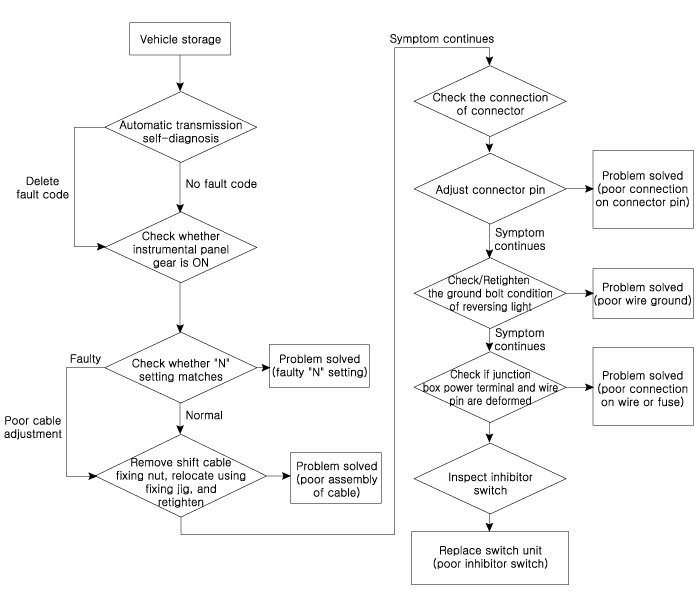 Hyundai Azera: Inhibitor Switch Repair procedures
Fifth generation HG (2011Ц2025) / Hyundai Azera 2011-2025 Service Manual / Automatic Transaxle System / Automatic Transaxle Control System / Inhibitor Switch Repair procedures
Hyundai Azera: Inhibitor Switch Repair procedures
Fifth generation HG (2011Ц2025) / Hyundai Azera 2011-2025 Service Manual / Automatic Transaxle System / Automatic Transaxle Control System / Inhibitor Switch Repair procedures
| Inspection |
|

| 1. |
Inspect DTC code. |
| 2. |
Inspect whether N setting matches.
|
| 3. |
Inspect shift cable separation.
|
| 4. |
Inspect whether connector is connected.
|
| 5. |
Inspect ground condition on reversing light circuit.
|
| 6. |
Inspect wiring connection on junction box power terminal and fuse lamp.
|
| 7. |
Inspect inhibitor switch signal.
|
| Removal |
| 1. |
Make sure vehicle does not roll before setting room side
shift lever and Automatic Transaxle(AT) side manual control lever to "N"
position. |
| 2. |
Remove the battery and the battery tray.
|
| 3. |
Remove the air cleaner assembly.
|
| 4. |
Remove the shift cable mounting nut (B).
|
| 5. |
Disconnect the inhibitor switch connector (A).
|
| 6. |
Remove the manual control lever (B) and the washer after removing a nut (A).
|
| 7. |
Remove the inhibitor assembly (A) after removing the bolts (2ea).
|
| Installation |
| 1. |
Installation is the reverse of removal. |
 Inhibitor Switch Troubleshooting
Inhibitor Switch Troubleshooting
Fault Diagnosis
Fault Diagnosis for Symptom
Major Symptom Expected Cause Items to Check and Measures Shift lever not operating Gear not marked on cluster Shock occurs wh ...
 Shift Lever Components and Components Location
Shift Lever Components and Components Location
Components
1. Shift lever knob2. Shift lever assembly 3. Control cable assembly4. Manual control lever (T/M side)
...
See also:
Overdrive Clutch Control Solenoid Valve(OD/C_VFS) Specifications
Specifications
Direct control VFS[OD/C]
? Control type : Normal low type
Control Pressure [kpa (kgf/cm?, psi)]500.14 ~ 9.81 (5.1 ~ 0.1, 72.54 ~ 1.42)Current value(mA)50~850 Internal resis ...
Radiator Repair procedures
Removal and Installation
1.
Remove the radiator upper hose and lower hose.
(Refer to Cooling System - "Radiator Hose")
2.
Remove the cooling fan assembly.
(Refer to Cooling System - "Cooli ...
Vehicle data collection and event data recorders
This vehicle is equipped with an event data recorder (EDR). The main purpose
of an EDR is to record, in certain crash or near crash-like situations, such as
an air bag deployment or hitting a road o ...







